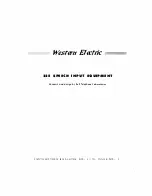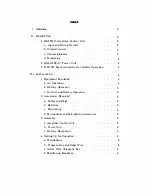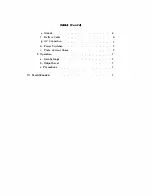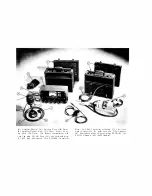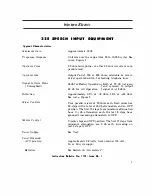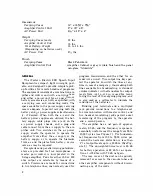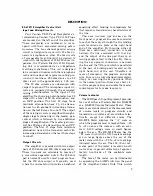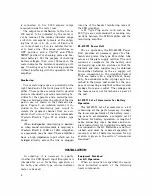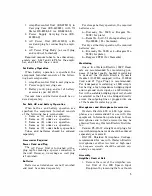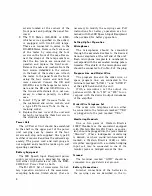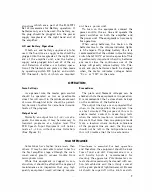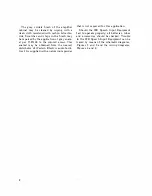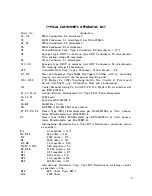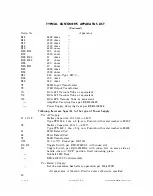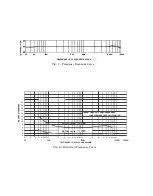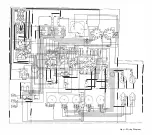
DESCRIPTION
ES-675710 Amplifier Control Unit
Input and Mixing Circuits
Four Cannon P3-13 Panel Receptacles ac
commodating Cannon Type P3-CG-12 Plugs
are mounted on the left end of the amplifier.
These receptacles are numbered to corre
spond with their associated mixing poten
tiometerR.
The
four
channel parallel
mixing
circuit is designed to work with 30 ohm dy
namic microphones or other 30 ohm circuits
of comparable level. Should it be desired to
work with microphones of 150/250 ohms im
pedance, the Western Electric 172A Repeat
ing Coil is recommended as an impedance
matching transformer. This coil is designed
to be connected in series with the microphone
cord and thus does not require mounting pro
visions. It matches a 250 ohm device to a 30
ohm circuit with approximately a 1 db loss.
The 30 ohm circuits are unbalanced with
respect to ground. The microphone input cir
cuits are connected through the associated
mixing potentiometers to the input of the
amplifier. Each mixing potentiometer has 20
steps with a total of 45 db attenuation, G'1d
an
OFF
position. The first 12 steps from
minimum attenuation have 1 'I:! db attenua
tion each, with gradually increasing attenua
tion on the last 8 steps to cut-off. The output
of the mixing circuits is amplified through a
single stage terminating in the master gain
control which is followed by two additional
stages of amplification. The master gain con
trol has 20 steps of attenuation and an OFF
position. The first 17 steps fr?m minim
�
m
attenuation have 2 db attenuation each with
increasing attenuation on the last three steps
to cut-off.
Output Circuits
The amplifier is provided with two output
pads of 150 ohms and 600 ohms respectively.
These two pads are selectable by means of
a screwdriver-operated switch. The 600 ohm
pad is normally used for most program lines.
but the 150 ohm output is frequently used
where the mismatch will provide a beneficial
equalizing effect tending to compensate for
the frequency transmission characteristics of
the line.
There are two lever type line keys on the
front panel. A program line may be connected
to each of these keys through the line binding
posts mounted on a plate at the right hand
end of the amplifier. By throwing either of
these keys downward, connection is made
between the line associated with that key
and the output of the line pad, thereby al
lowing program feed to that line. By throw
ing the key upward, connection is between
the line and the TEL jack which is paralleled
to the pair of binding posts located on t
�
e
right hand end of the unit. Therefore,
m
cases of emergency the program and order
wire lines can be interchanged immediately
simply by reversing the key positions. Wh
�
n
in the normal position, these keys short cir
cuit the program lines and enable the master
control operator
to
make loop tests.
Volume Indicator
The 22E Speech Input Equipment provides
for use of either a Western Electric KS-8208
or a KS-8218 Volume Indicator Meter. These
meters are standardized for the measurement
of volume levels in program circuits and
transmission systems and are identical elec
trically except for different scales. The
KS-8208 Meter employs the "A" scale on
which the program level is marked from -20
to +3 vu above the scale arc, with an arbi
trary 0-100 voltage scale in small figures
below the arc. The KS-8218 Meter has the
"B" scale in which the 0-100 scale markings
are in large figures above the arc of the
meter scale, with the -20
to
+3 vu markings
indicated below the arc. The 100 (0 vu) ref
erence point of the meter is located
OJI
bot
�
scales so as to permit utilization of approxi
mately two-thirds of the available scale
length.
The face of the meter can be illuminated
by operating the LAMP switch on the panel
of the Amplifier-Control Unit. This switch
3


